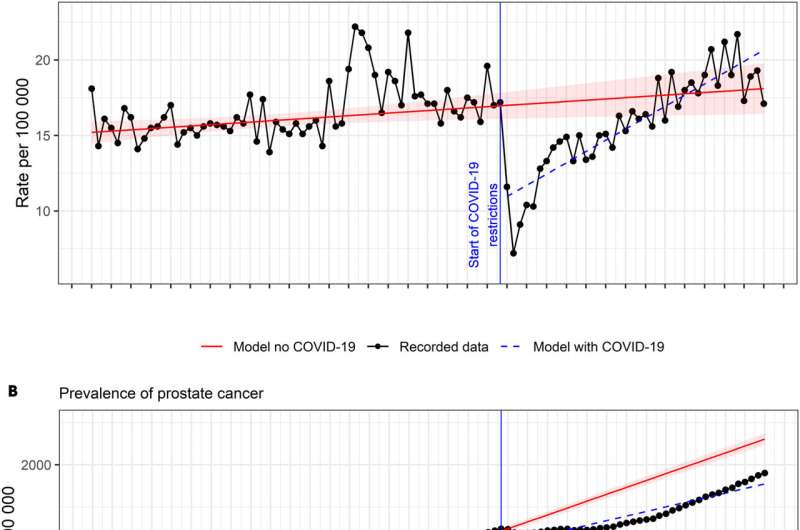This article has been reviewed according to Science X's editorial process and policies. Editors have highlighted the following attributes while ensuring the content's credibility:
fact-checked
trusted source
proofread
COVID-19 pandemic could have led to 20,000 prostate cancer diagnosis being missed

Prostate cancer diagnoses in 20,000 men could have been missed due to the COVID-19 pandemic, finds a new study published in BJU International from the University of Surrey and the University of Oxford.
Increased waiting times and changes in people's behavior in seeking medical attention during the pandemic could be responsible for missed diagnoses.
During this study, scientists sought to investigate the effect of the COVID-19 pandemic on diagnoses and mortality rates for prostate cancer in England. Using data from OpenSAFELY, comprising 24 million electronic health care records of people registered with primary care providers, scientists analyzed prostate cancer incidence between January 2015 and July 2023.
Lead author Dr. Agnieszka Lemanska, senior lecturer in health data science at the University of Surrey, said, "Understandably, during the COVID-19 pandemic, resources and attention in health care systems shifted towards preventing and managing the virus. This was to the detriment of other areas of the health service including cancer care.
"Early cancer diagnosis is key to improving cancer-related outcomes and long-term survival. It is important that we learn the lessons from the pandemic however, to do this we need to fully understand the scale of how services and diagnosis rates were impacted during this time."
To assess the effect of COVID-19, scientists used pre-pandemic data and statistical models to predict the expected rates of prostate cancer from March 2020, as if the pandemic had not happened.
Analyzing the data from 285,160 participants, scientists found that in 2020, 15,550 new diagnoses were in the dataset, compared to the predicted 20,322, a drop in diagnosis rates of 4,772 (31%). In 2021, there were 17,950 recorded instances of prostate cancer, compared to the estimated 21,098, a decline of 3,148 (18%). By 2022, the incidence of diagnoses returned to the levels that would have been expected.
Scientists then modeled these findings from the OpenSAFELY dataset, which represents 40% of the English population and estimated that the drop in incidence represented approximately 20,000 missed cases in England.
In addition, two peaks in mortality from prostate cancer were also identified by scientists, one in April 2020 and another in January 2021, when prostate cancer-related mortality increased from approximately 5.5 to 8.5 and 7.5 deaths per 100,000, respectively. Scientists note that these two peaks coincided with the two national lockdowns in the U.K. These mortality changes were transient and, therefore, not explored with statistical models.
Interestingly, scientists also identified a shift in characteristics of men diagnosed with prostate cancer during the pandemic. Men diagnosed during the pandemic were more likely to be older, as the data revealed in 2020, the average age at diagnosis was 71.6, which was higher than the average age in 2019 of 71.3. The average age in 2021 again increased to 71.8 years old. By 2022, the age at diagnosis dropped to 71.4 and dropped again in 2023 to 71.0 years, which meant it returned to the pre-pandemic values.
Dr. Agnieszka Lemanska added, "Although incidences of the cancer have returned to pre-pandemic levels by the end of 2022, there has not been an increase in diagnoses to account for the missed cases. The prevalence of prostate cancer at the end of our study was still lower than it would have been if the pandemic had not occurred. The ramifications of the pandemic are still being felt and we need to do more to investigate the consequences of this on patients and health care systems."
More information: Agnieszka Lemanska et al, During the COVID‐19 pandemic 20,000 prostate cancer diagnoses were missed in England, BJU International (2024). DOI: 10.1111/bju.16305




















